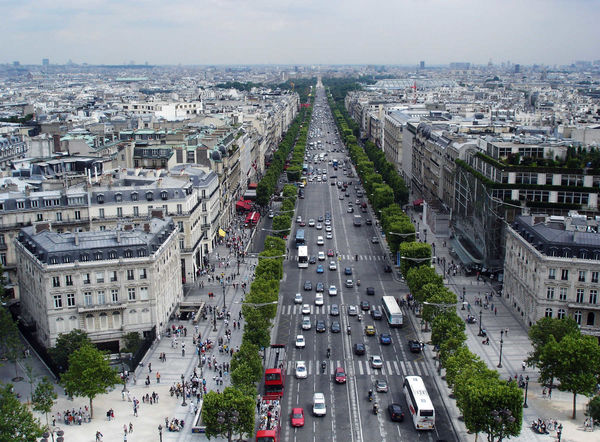Promenading on Paris’ Champs-Elysées
By Rick Steves
When I think of Paris, I think of mint- and rose-flavored macarons…on the Champs-Elysées. A stroll down on Europe's grandest boulevard gives you Paris at its most Parisian: sprawling sidewalks, stylish octogenarians caked in make-up, concept cars in glimmering showrooms, and pastel macarons in grand cafés.
Europe's characteristic love of strolling (a stately paced triathlon of walking, window shopping, and high-profile sipping) dates from the booming 19th century, with its abundance of upper-class leisure time and cash.
So, don an aristocratic air. From the Arc de Triomphe, amble gently downhill to the immense and historic square called the Place de la Concorde. But before you stroll the boulevard, you must master the name. Say it: shahn-zay-lee-zay.
Even small-town French kids who haven't traveled beyond a TV screen know that this is their country's ultimate parade ground, where major events unfold: the Tour de France finale, Bastille Day parades, and New Year's festivities.
In 1667, Louis XIV opened the first stretch of the Champs-Elysées: a short extension of the Tuileries Gardens leading to the palace at Versailles. Many consider this date to be the birth of Paris as a grand city. The Champs-Elysées soon became the place to cruise in your carriage. (It still is today — traffic can be jammed up even at midnight.)
Until the 1960s, this was a street of top-end hotels, cafés, and residences — pure Parisian elegance. Locals actually dressed up to stroll here. Then, in 1963, the government, wanting to pump up the neighborhood's commercial metabolism, brought in the RER (underground light rail). Suddenly, suburbanites had easy access. And bam — there went the neighborhood.
The arrival of McDonald's was a shock. At first it was allowed only white arches painted on the window. Today, the hamburger joint spills out onto the sidewalk with café-quality chairs and stylish flower boxes.
As fast food and pop culture invaded and grand old buildings began to fall, Paris realized what it was losing. In 1985, a law prohibited the demolition of the classy facades that once gave this boulevard a uniform grace. Consequently, many of today's modern businesses hide behind preserved facades.
When the avenue was revitalized in 1994, two lanes of traffic were traded away to make broader sidewalks (and plans are underway to make it pedestrian-only again by 2030). Now the Champs-Elysées has had plentiful street benches, snazzy streetlamps, and an army of green-suited workers armed with high-tech pooper scoopers. And plane trees (a kind of sycamore that thrives despite big-city pollution) provide a leafy ambience for the cafés.
A century after Louis XIV, the café scene arrived. Cafés were ideal for Parisian pleasure-seekers and thinkers to share ideas and plot revolutions. That coffee-sipping ambience survives today, amid pop clothing outlets and music megastores. Two cafés, Le Fouquet's and Ladurée (a block apart on the quiet side of the boulevard), are among the most venerable in Paris.
Fouquet's started as a coachman's bistro. Then it gained fame as the hangout of French biplane pilots during World War I. (Paris was just a few nervous miles from the Western Front.) Today it's pretty stuffy — unless you're a film star. The golden plaques at the entrance honor winners of France's version of our Oscars, the Césars. While I find the interior intimidating, the people-watching from the sidewalk seating makes the most expensive espresso I found in Paris ($10+) a good value.
You're more likely to see me hanging out at Ladurée, working delicately through an Oreo-sized macaron with fine silverware. This classic 19th-century tea salon/restaurant/pastry shop has an interior right out of the 1860s. The bakery makes traditional macarons — with a pastel palette of flavors ranging from mint and raspberry to rose. Get a frilly little gift box to go, or pay the rançon and sit down and enjoy the Champs-Elysées show.
As you stroll, you'll notice the French appetite for a good time. The foyer of the famous Lido, Paris' largest cabaret, comes with leggy photos and a perky R-rated promo video.
The Club Med building is a reminder of the French commitment to the vacation. Since 1936, France employees, by law, have enjoyed one month of paid vacation. The French — who now have five weeks of paid vacation — make sure they have plenty of time for fun.
On the Champs-Elysées, the shopping ends and the park begins at a big traffic circle called Rond-Point. From here, it's a straight shot down the last stretch of the boulevard to the sprawling 21-acre square called the Place de la Concorde. Its centerpiece is the 3,300-year-old Obelisk of Luxor. It was carted here from Egypt in the 1830s, a gift to the French king.
Standing in the shadow of that obelisk with your back to the Louvre while you look up Europe's ultimate boulevard, you can't help but think of the sweep of French history…and those delightful macarons.

